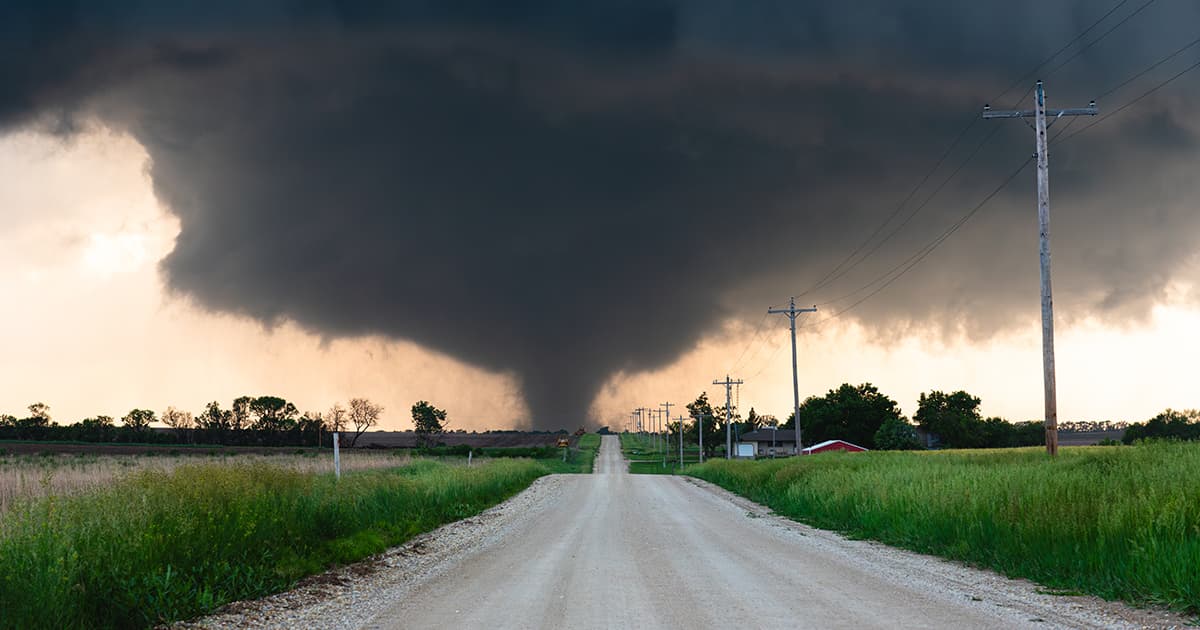Am I Covered After a Tornado Hits My House?

When a tornado touches down, it can result in devastating damage. For homeowners, the aftermath leads to one pressing question: Does my home insurance cover tornadoes?
Let’s take a look at home insurance coverage for tornadoes, how to file a claim after tornado damage, safety tips during a tornado, and what homeowners need to know to protect their property.
When is tornado season in Canada?
Tornadoes are most common in southern Quebec, Ontario, and Alberta, as well as western New Brunswick, and across Manitoba and Saskatchewan.
Tornado season is usually between April and September, with the strongest winds in June and July.
Understanding tornadoes and their impact
Tornadoes are violent windstorms characterized by a twisting, funnel-shaped cloud. They can cause significant destruction in a matter of minutes, demolishing buildings, uprooting trees, and hurling debris at high speeds.
In Canada, tornado season typically peaks in the months of June and July. During this period, conditions are most favorable for tornado development, with the warm, moist air from the Gulf of Mexico meeting cooler, dry air from the north.
This confluence can lead to severe thunderstorms, some of which may spawn tornadoes. The Canadian Prairies and Southern Ontario are particularly susceptible to these storms.
Does home insurance cover tornado damage?
The good news for homeowners is that most standard home insurance policies do cover damage caused by tornadoes.
Tornadoes fall under the category of windstorms, which are typically included in a standard home insurance policy. This means that if your home is damaged or destroyed by a tornado, your insurance should help cover the costs of repairs or rebuilding.
It’s essential, though, to thoroughly review your home insurance policy to understand the specifics.
Here are a few key points to consider:
1. Dwelling coverage: This covers the structure of your home, including the roof, walls, and foundation. If a tornado damages or destroys your home, dwelling coverage will help pay for repairs or rebuilding.
2. Personal property coverage: This part of your policy covers the contents of your home, such as furniture, electronics, and clothing. If your belongings are damaged or destroyed by a tornado, personal property coverage will help replace them.
3. Additional living expenses: If your home is uninhabitable due to tornado damage, additional living expenses coverage can help with the cost of temporary housing and other necessary expenses, such as meals and storage.
4. Deductibles and limits: Be aware of your policy's deductibles and coverage limits. The deductible is the amount you need to pay out of pocket before your insurance kicks in. Coverage limits are the maximum amounts your insurance will pay for a covered loss.
Filing a claim after tornado damage
If your home is damaged by a tornado, filing an insurance claim is the first step towards recovery. Here’s how to navigate the process:
1. Document the damage: Take photographs or videos of the damage to your home and belongings. This will serve as evidence for your claim.
2. Contact your insurance company: Report the damage to your insurance company as soon as possible. Provide them with all necessary information and documentation.
3. Meet with an adjuster: Your insurance company will send an adjuster to assess the damage. Be sure to provide the adjuster with access to your property and any additional information they may need.
4. Get repair estimates: Obtain estimates from reputable contractors for the repair work. Your insurance company may require multiple estimates to ensure the costs are reasonable.
5. Keep records: Maintain detailed records of all communications with your insurance company, as well as receipts for any expenses related to the damage and repairs.
6. Understand your settlement: Once your claim is approved, your insurance company will provide a settlement. Ensure you understand the terms and what is covered. If you have any questions or disputes, address them promptly with your insurer.
Here are some essential tornado safety tips:
1. Stay informed: Keep an eye on weather forecasts and listen to local news for tornado watches and warnings. A tornado watch means conditions are favorable for tornadoes, while a warning means a tornado has been sighted or indicated by radar.
2. Create a safety plan: Develop a family emergency plan that includes a designated safe room, usually a basement or an interior room on the lowest floor with no windows. Practice your plan regularly.
3. Prepare an emergency kit: Assemble a kit with essential items such as water, non-perishable food, a flashlight, batteries, a first-aid kit, medications, and important documents.
4. Take shelter immediately: If a tornado warning is issued, take shelter immediately. Do not wait until you see the tornado. Go to your designated safe room and protect yourself from flying debris by covering yourself with a mattress or heavy blankets.
5. Stay away from windows: Flying glass and debris can cause serious injuries. Stay away from windows and cover yourself to avoid harm.
6. Monitor the situation: Use a battery-operated radio to stay informed about the storm’s progress and any additional warnings or updates.
Tornadoes, particularly in Canada during June and July, pose significant risks. By staying informed, creating a safety plan, and having the right insurance coverage, you can better protect your home and loved ones.



